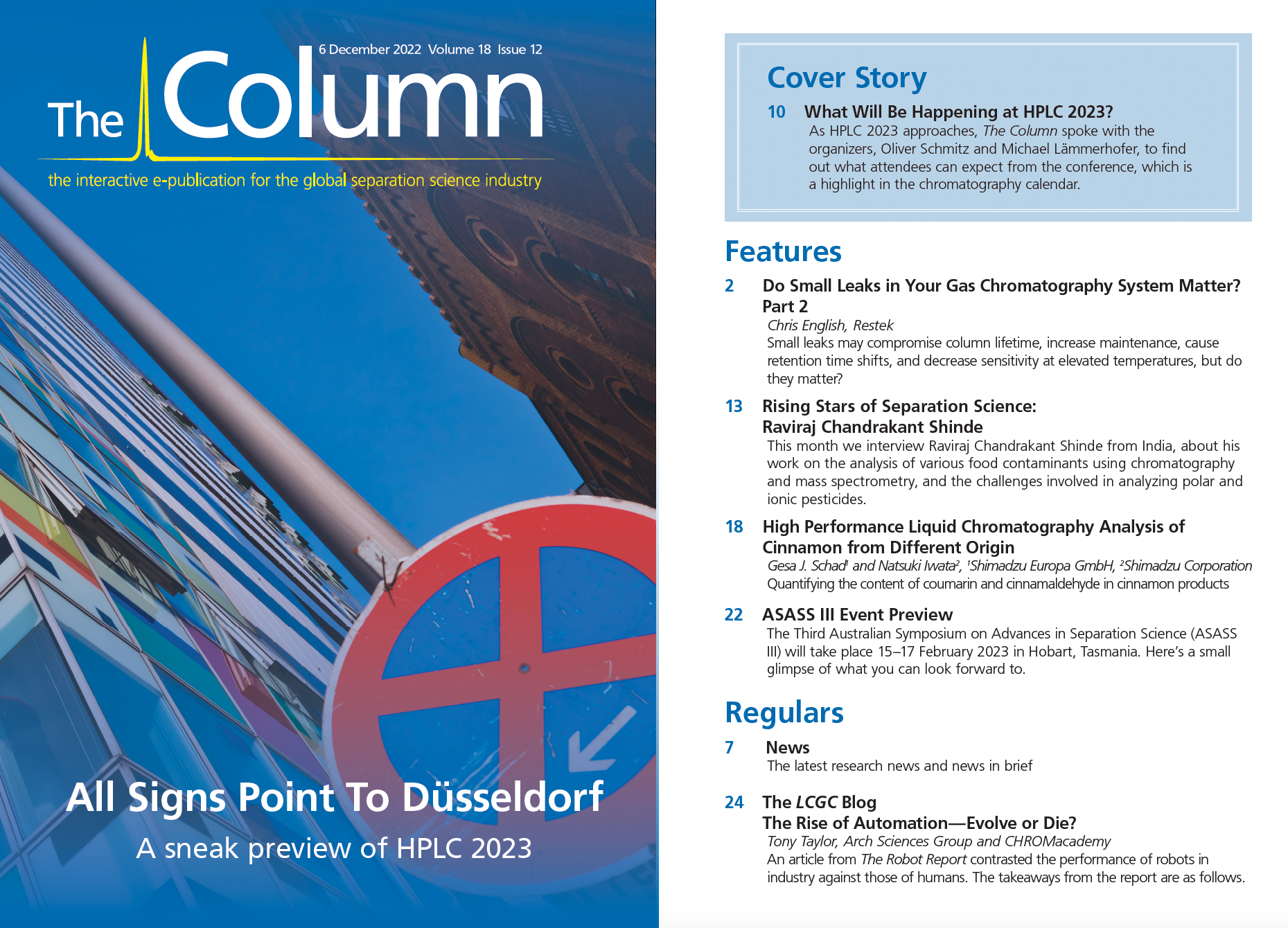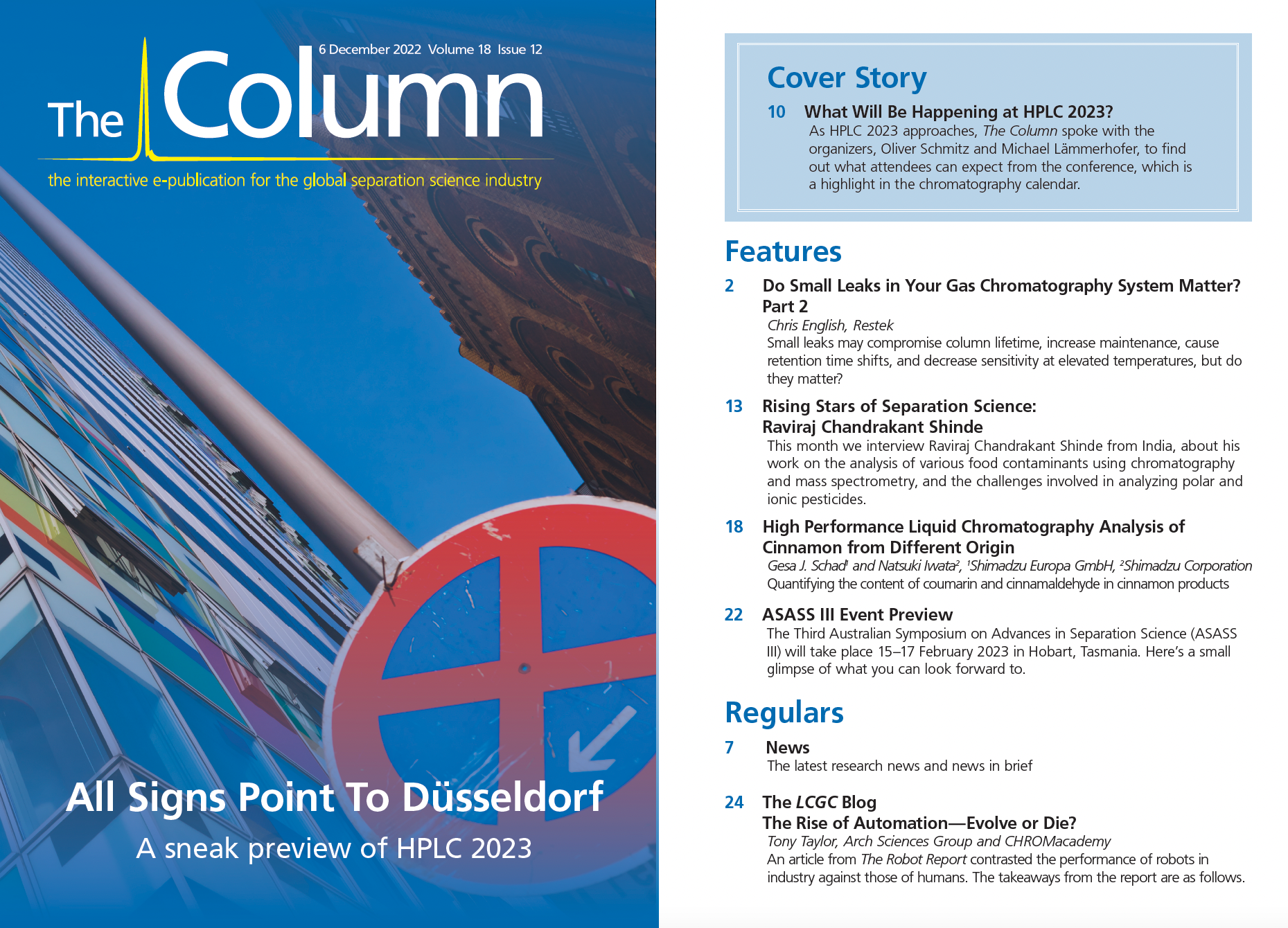Rising Stars of Separation Science: Raviraj Chandrakant Shinde
This month we interview Raviraj Chandrakant Shinde from India, about his work on the analysis of various food contaminants using chromatography and mass spectrometry, and the challenges involved in analyzing polar and ionic pesticides.
Q. When did you first encounter chromatography and what attracted you to the subject?
A: I was a master’s student in the Department of Agrochemicals and Pest Management at Shivaji University, Kolhapur (Maharashtra, India) and visited UPL Limited, Thane (formerly known as United Phosphorus Ltd.) for a one month training programme as part of my studies in 2015. It was here that I saw chromatographic and mass spectrometry instruments up close for the first time, and it was an unforgettable and awesome moment in my life. I understood it to be a very interesting technique that provides an accurate analysis of various compounds. Because of my good fortune, I was able to receive my initial training from Mayur Aitawade (theoretical topics) and Prem Naik (theoretical themes proven with a practical approach), who taught me these techniques very nicely and with proper demonstration. I will be eternally grateful to the team at UPL Limited., Thane, for the excellent training in analytical techniques and formulation. I am especially grateful to respected Madhukar Deshmukh (Shivaji University, Kolhapur) and the team at UPL, Thane (India): Satish Bhoge, Sujata Desai, Mayur Aitawade, Prem Naik, Abhishek Karekar, Dilip Patel, Prakash Kondalkar, Ajay Chhatre, and the rest of the R&D team.
Q. Can you tell us more about your Ph.D. thesis?
A: I completed my Ph.D. at the Department of Agrochemicals and Pest Management, Shivaji University, Kolhapur, under the guidance of P.D. Shiragave, Devchand College, Arjunnagar, Maharashtra, India. My work was mainly focused on the development of new analytical methods for pesticide residue analysis in cereals, pulses, nuts, and processed products. I have developed analytical methods using various sophisticated analytical techniques such as liquid/gas chromatography (LC/ GC) with mass spectrometry (MS), and also performed qualitative analysis by atmospheric-pressure matrix-assisted laser desorption–ionization high resolution mass spectrometry (AP-MALDI–HRMS). My Ph.D. work included the development of an analytical method for highly polar herbicides, a novel method for multiresidue analysis of thermally unstable fungicides (captan, captafol, and folpet analysis by LC–electrospray ionization [ESI]-MS/MS without any degradation), and development of a large-scale multiresidue analytical method for the analysis of 400+ pesticides and mycotoxins in fatty matrices using LC–MS/MS and GC–MS/MS. These methods were thoroughly validated to AOAC-SMPR and SANTE guidelines and complied with regulatory requirements. These methods are useful for regulatory enforcement, as well as high-throughput commercial residue testing purposes.
Q. What chromatographic techniques have you worked with?
A: I have employed various chromatographic and mass spectrometric techniques in my research, where I have developed many analytical methods for the wide nature of compounds. I am interested in research focused on food analytical chemistry, with a special emphasis on analytical method optimization, development, and validation for the multi- as well as single residue analysis of different food contaminants such as pesticides, antibiotics, veterinary drugs, food adulterants, and mycotoxins. I have used different chromatographic techniques such as high performance liquid chromatography (HPLC) or gas chromatography with basic (UV–vis, fluorescence, flame ionization detection [FID]) and advanced detectors, including triple quadrupole, LC–quadrupole time‑of‑flight [QTOF]-MS, and LC–orbital trap.
Q. Your research focus currently lies in the analysis of various food contaminants using chromatography and mass spectrometry—what specifically attracted you to this area of research?
A: My research is focused on the analysis of various food contaminants such as pesticides, antibiotics, veterinary drugs, food adulterants, and mycotoxins. The analysis of these food contaminants is very critical. Sometimes it is very simple, but sometimes it can be very difficult, especially for some challenging compounds. It depends on the nature of the targeted compounds and the nature of the food commodity. Consequently, this is a very interesting and challenging part of food contaminant analysis, as although we are analyzing the same compounds, if we are changing the food commodity (matrices), the development/ modification of an extraction method is very vital.
For example, if we are analyzing pesticides from fruits (grape, mango, and orange), after the extraction, we need to perform clean up with only primary secondary amines (PSA). However, if we are doing this for complex matrices, such as nuts, cereals, or pulses, we need to use some other clean-up sorbents, such as C18 along with PSA (freezing step for fatty matrices). So, nothing is always ready to go here, but we always need to look for a new or improved way to take the next step. This is a very interesting task in food contaminant analysis using chromatographic techniques and attracted me towards this field.
Q. You have recently published a paper on the analysis of polar and ionic pesticides in grape and pomegranate using LC–MS/MS (1). What are the challenges you faced during the development of a method for the analysis of these challenging to analyze highly polar and ionic compounds? How did you establish this method?
A: Globally, various multiresidue methods (QuEChERS- or ethyl acetate-based) are used for the extraction and analysis of multiclass pesticides in a single method. However, polar and ionic compounds cannot be satisfactorily recovered by regular multiresidue sample preparation workflows or in multiresidue analytical methods because these compounds are predominantly soluble in polar solvents such as water or methanol. These ionic and highly polar compounds mainly include herbicides such as glyphosate, glufosinate and their metabolites, and a few other pesticides such as ethephon and fosetyl‑Al (with its metabolite phosphonic acid). Analysis of these polar pesticides is very challenging on reversed‑phase column chemistry (octadecylsilane) because they get eluted in the void volume with reversed-phase columns. To improve the retention of these compounds on reversed-phase column chemistry requires derivatization with 9-fluorenylmethylchloroformate (FMOC-Cl). This derivatization step increases the molecular weight as well as changes the chemical nature of the targeted compounds, which helps to increase the chromatographic retention on the reversed-phase column. However, derivatization with the FMOC-Cl step is tedious and lengthy. On the other hand, the direct analysis (without derivatization) requires a specific instrument in the laboratory, for example, an ion chromatographic system, which increases the cost.
To overcome these obstacles, I developed new and improved analytical methods for the analysis of these difficult-to-analyze, highly polar, and ionic compounds. There was a significant challenge during this development; various column chemistries are available on the market to improve retention. However, when it comes to the practical on instrument, it is difficult to analyze all compounds along with their metabolites in a single chromatographic run using a base‑to‑base separation. However, I optimized each and every step, from mobile phase, chromatography (selection of column chemistry), mass spectrometry parameters (optimization of source parameters), and sample preparation workflow (without derivatization). This was a very interesting and challenging task. Finally, a simple method was developed that allows for the simultaneous analysis of parent compounds and their metabolites in a single chromatographic run with separation. This method is suitable for regulatory testing of the targeted compounds because they provide satisfactory repeatability and reproducibility.
Q. Another of your recent papers presents for the first time a method for the multiresidue analysis of multiclass pesticides in sesame seeds using LC–MS/MS and GC–MS/MS (2). What does this method offer over existing ones? Could this method be used in the analysis of other foodstuffs?
A: In 2020, public exposure to chemical contaminants through sesame seeds drew serious regulatory attention. A new regulation of the European Union 2020/1540 (22 October 2020) was brought into being, commanding that all imported sesame consignments from India must be analyzed for the residues of ethylene oxide along with pesticides. Therefore, this study was focused on sesame seeds for the development and validation of an analytical method for multiclass pesticides only.
Pesticide analysis from fatty matrices has been a difficult task for every chemist or scientist in the food industry, and sesame seeds are tricky. Sesame seeds (fatty matrix) contain higher proportions of lipids, posing challenges for pesticide extraction and analysis in provide satisfactory repeatability and reproducibility.
Q. Another of your recent papers presents for the first time a method for the multiresidue analysis of multiclass pesticides in sesame seeds using LC–MS/MS and GC–MS/MS (2). What does this method offer over existing ones? Could this method be used in the analysis of other foodstuffs?
A: In 2020, public exposure to chemical contaminants through sesame seeds drew serious regulatory attention. A new regulation of the European Union 2020/1540 (22 October 2020) was brought into being, commanding that all imported sesame consignments from India must be analyzed for the residues of ethylene oxide along with pesticides. Therefore, this study was focused on sesame seeds for the development and validation of an analytical method for multiclass pesticides only.
Pesticide analysis from fatty matrices has been a difficult task for every chemist or scientist in the food industry, and sesame seeds are tricky. Sesame seeds (fatty matrix) contain higher proportions of lipids, posing challenges for pesticide extraction and analysis in routine samples. The issues were high matrix effects during analysis and a decrease in LC–MS/MS sensitivity caused by co‑extracted lipid deposition in the ion source. Previous methods targeted a limited number of pesticides or required a time-consuming and lengthy sample preparation workflow. To overcome these obstacles, LC–MS/MS and GC–MS/MS were used to develop a simple method for extracting a large number of pesticides (400+) from sesame seeds.
This method is very simple and robust, and it can be used in a food testing laboratory. Furthermore, given the method’s performance, it can be used for pesticide residue analysis in other oil seed matrices as well.
Q. You have also developed a simple, rugged, and short method for the analysis of patulin (3). This method is recognized by the Food Safety and Standards Authority of India (FSSAI) for inclusion in the official food testing manual. How difficult was this method to implement?
A: Patulin, a toxic metabolite of fungus that is predominantly found in apples and its processed products, can pose severe health hazards to humans (patulin‑producing pathogen is Penicillium expansum). Given its toxicological significance, many regulatory bodies have imposed stringent restrictions on the levels of contamination of this mycotoxin. Therefore, analysis of patulin from apple and its processed products is important.
A simple, rapid, sensitive, and robust analytical method was developed that ensures high throughput analysis of patulin within 5 min. The method does not involve any lengthy and complicated clean-up steps; and so it is less expensive and more time-effective compared with previously published methods. The developed method is aligned with the analytical quality control criteria and complies with the requirements of CODEX, EU, FSSAI, and US FDA.
The method has been adopted by the nodal-government agency-Food Safety and Standards Authority of India in their official food testing manual (4). The method can be implemented in regulatory and commercial food testing laboratories. Considering its accuracy, repeatability, and reproducibility, the method is fit‑for‑purpose for testing of patulin in apple and its processed products.
Q. Anything else you would like to add?
A: I am always thankful to my family (Shinde, Taur, Shejul, and Jadhav) for their tremendous support throughout the whole journey. I am also thankful to all my professors, teachers, and all my friends for believing in me.
References
- R. Shinde et al., Journal of AOAC International 105(5), 1341–1349 (2022).
- R. Shinde et al., Journal of Chromatography A 1652, 462346 (2021).
- R. Shinde et al., Mycotoxin Research 37(2), 119–127 (2021).
- https://fssai.gov.in/upload/uploadfiles/ files/Order_Manual_Analysis_ Mycotoxins_20_07_2021.pdf, pp. 87–89.

Raviraj Chandrakant Shinde has a bachelor’s degree in chemistry, and a master’s degree and Ph.D. in agrochemicals and pest management (chemistry). To further continue his work and to gain more knowledge in his research subject, he has enrolled in a master’s in chemistry at Singhania University in India. His work is mainly focused on the development of new analytical methods for the analysis of various food contaminants. He has developed several analytical methods and successfully validated for the multi- as well as single residue analysis of different food contaminants such as pesticides, veterinary drugs, antibiotics, food adulterants, and mycotoxins using different chromatographic (LC and GC) and mass spectrometric techniques (triple quad, single quad, QTOF-MS, orbital trap). He has received many national and international awards, such as the Eurofins Foundation “Testing for Life” Award in 2021 in Boston, USA; the Herbalife Nutrition Award in 2022 at Scottsdale, Arizona, USA, from AOAC International; the InSc-Young Researcher Award-2021; the INSO-Emerging Scientist Award-2022; and various other awards and recognitions.
Rising Stars of Separation Science
The Column will be running a series of interviews in 2023, featuring the next generation of separation scientists. If you would like to nominate a “rising star” for consideration, please send the name of the candidate and why they deserve recognition to Alasdair Matheson, Editor‑in‑Chief, LCGC Europe and The Column at amatheson@mjhlifesciences.com

Analytical Challenges in Measuring Migration from Food Contact Materials
November 2nd 2015Food contact materials contain low molecular weight additives and processing aids which can migrate into foods leading to trace levels of contamination. Food safety is ensured through regulations, comprising compositional controls and migration limits, which present a significant analytical challenge to the food industry to ensure compliance and demonstrate due diligence. Of the various analytical approaches, LC-MS/MS has proved to be an essential tool in monitoring migration of target compounds into foods, and more sophisticated approaches such as LC-high resolution MS (Orbitrap) are being increasingly used for untargeted analysis to monitor non-intentionally added substances. This podcast will provide an overview to this area, illustrated with various applications showing current approaches being employed.
New Study Reviews Chromatography Methods for Flavonoid Analysis
April 21st 2025Flavonoids are widely used metabolites that carry out various functions in different industries, such as food and cosmetics. Detecting, separating, and quantifying them in fruit species can be a complicated process.
University of Rouen-Normandy Scientists Explore Eco-Friendly Sampling Approach for GC-HRMS
April 17th 2025Root exudates—substances secreted by living plant roots—are challenging to sample, as they are typically extracted using artificial devices and can vary widely in both quantity and composition across plant species.

.png&w=3840&q=75)

.png&w=3840&q=75)



.png&w=3840&q=75)



.png&w=3840&q=75)
















